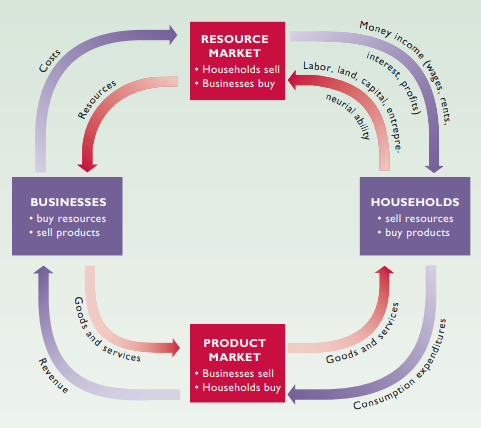Chapter 2: The Market System and the Circular Flow
Economic system - A particular set of institutional arrangements + coordinating mechanism used to respond to the economizing problem
- Determine what goods produced, how goods are produced, who gets them, etc.
Command system - Socialism/communism; gov’t owns most property + economic decision-making occurs through central economic plan
- Central planning board makes all major decisions
- Firms produce according to gov’t directives
- Some private ownership
Market system - Capitalism; private ownership of resources + use of markets/prices to coordinate economic activity
- Acting in own self-interest
- Competition among independently acting buyers + sellers
- Laissez-faire capitalism - Limited gov’t interference w/ economy
- Characteristics
- Private property - Private individuals + firms own most property resources; encourages investment, innovation, economic growth
- Freedom of enterprise - Entrepreneurs + businesses can obtain resources to produce + sell goods
- Freedom of choice - Owners can employ property/money as they see fit; consumers can buy goods and services that best satisfy their wants
- Self-interest - Each economic unit tries to achieve its own particular goal, usually delivering something of value to others
- Competition - Between economic units; based on freedom of choice in pursuit of monetary return; spreads economic power between businesses + households
- Markets - Institution/mechanism that brings buyers + sellers into contact
- Technology and capital goods
- Specialization - Use of resources to produce a few goods instead of an entire range
- Division of labor - Human specialization
- Medium of exchange - Function of money; makes trade easier
- Barter - Swapping goods and services for each other; requires coincidence of wants between buyers and sellers
- Money - Convenient social invention to facilitate exchanges of goods and services
- Active but limited government
Five fundamental questions
- What goods and services will be produced?
- Only goods and services produced at continuing profit will be produced
- Consumer sovereignty - Consumers spend income on goods they are willing + able to buy
- “Dollar votes” - Consumers using dollars to show what goods + services they want in the market; determine which industries survive and fail
- How will the goods and services be produced?
- Least-cost production - Most economically efficient techniques of production
- Who will get the goods and services?
- Products distributed to consumers based on who is willing and able to pay
- Depends on income, prices, and preferences
- How will the system accommodate change?
- Changes as consumer preferences, production techniques, and resource supplies change
- Directs expansion/contraction of industries
- How will the system promote progress?
- Technological advance
- Creative destruction - Creation of new products + production methods destroys market positions of firms relying on existing products and older business ways
- Capital accumulation (dollar votes for capital goods)
“Invisible hand” - As firms seek to further their own self-interest in a market system, they simultaneously promote social interests
- Efficiency - Efficient use of resources by guiding them to production of wanted goods + services
- Incentives - Skill acquisition, hard work, innovation
- Freedom - Economic activity without coercion
Problems with command systems
- Coordination problem
- Central planners coordinating millions of individual decisions
- Failure of single industry → Affected several other industries
- Planning techniques ineffective for large economies
- Incentive problem
- Persistent shortages + surpluses
- No incentive to adjust production to fluctuations
Circular flow diagram - Shows repetitive flows of goods, services, resources, and money through the economy
- Resource market - Where resources by households sold to businesses
- Product market - Where goods and services produced by businesses sold to households
